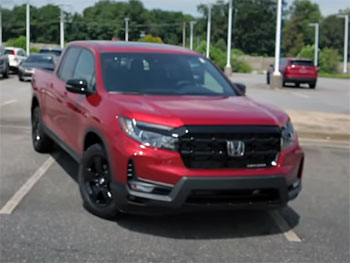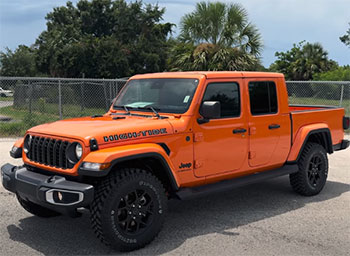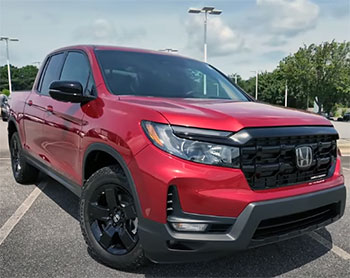I’ve always been drawn to pickup trucks for their versatility, whether it’s hauling gear for a weekend adventure or tackling daily commutes with ease. When I decided to compare the 2025 Honda Ridgeline and the 2025 Jeep Gladiator, I wanted to see which one better suits my lifestyle—and maybe yours too.
This article chronicles my hands-on experience with both trucks, weighing their strengths and weaknesses to help you decide which midsize pickup fits your needs. From city streets to off-road trails, I’ll share what I discovered about their performance, comfort, and unique features, all while keeping it real and relatable.
Comparison Table: Honda Ridgeline Vs. Jeep Gladiator
| Feature | Honda Ridgeline (2025) | Jeep Gladiator (2025) |
|---|---|---|
| Base Price | $41,600 | $40,095 |
| Engine | 3.5L V6 (280 hp, 262 lb-ft) | 3.6L V6 (285 hp, 260 lb-ft) |
| Transmission | 9-speed automatic | 6-speed manual or 8-speed automatic |
| Drivetrain | AWD standard | 4WD standard |
| Fuel Economy (Combined) | 21 mpg | 19 mpg |
| Towing Capacity | 5,000 lbs | 7,700 lbs |
| Payload Capacity | 1,583 lbs | 1,710 lbs |
| Bed Length | 64 inches | 60.3 inches |
| Ground Clearance | 7.6 inches | 11 inches |
| Safety Rating (NHTSA) | 5 stars | 3 stars (rollover) |
| Reliability (Consumer Reports) | 78/100 | 45/100 |
| Key Features | In-bed trunk, dual-action tailgate, Honda Sensing suite | Removable top/doors, off-road capability, TrailCam |
My Experience With the Honda Ridgeline

When I first slid into the driver’s seat of the 2025 Honda Ridgeline, it felt like stepping into a refined SUV rather than a traditional pickup.
The unibody construction, shared with models like the Honda Passport, gives it a smooth, car-like ride that’s a standout in the midsize truck segment.
I drove the RTL-E trim through city streets and winding backroads, and its handling impressed me.
The 3.5-liter V6 engine, producing 280 horsepower, felt peppy enough for merging onto highways, and the nine-speed automatic transmission shifted seamlessly.
I clocked a 0-60 mph sprint in about 7 seconds, which felt quick for a truck.
The Ridgeline’s interior is where it really shines. The cabin is spacious, with supportive seats and a layout that’s intuitive and functional. I appreciated the 8.0-inch touchscreen, which, while not the flashiest, was easy to navigate with standard wireless Apple CarPlay and Android Auto.
The rear seats offered ample legroom for my 6-foot-tall friend, and the ability to flip them up for extra cargo space was a game-changer when I needed to haul some camping gear. The in-bed trunk—a 7.3-cubic-foot lockable compartment—was perfect for stashing valuables, and the dual-action tailgate, which opens both downward and sideways, made loading and unloading a breeze.
Off-road, the Ridgeline TrailSport trim I tested held its own on light trails, thanks to its i-VTM4 all-wheel-drive system with modes for snow, sand, and mud. However, with only 7.6 inches of ground clearance, I was cautious around rocky terrain. It’s not a rock-crawler, but it handled gravel paths and muddy forest trails without breaking a sweat.
The Ridgeline’s fuel economy, averaging 21 mpg combined, was a pleasant surprise during a 300-mile road trip, making it a practical choice for long drives.
What struck me most was the Ridgeline’s versatility. It’s a truck that feels equally at home running errands in the city or heading out for a weekend getaway. Its reliability, backed by a Consumer Reports score of 78/100, gave me confidence it wouldn’t leave me stranded.
The Honda Sensing safety suite, with features like adaptive cruise control and lane-keeping assist, added peace of mind, especially in heavy traffic.
My Experience With the Jeep Gladiator

The 2025 Jeep Gladiator, on the other hand, is a completely different beast.
Climbing into the Rubicon trim felt like gearing up for an adventure. Its rugged, boxy design, complete with removable doors and a convertible top, screamed personality.
The 3.6-liter V6 engine, delivering 285 horsepower, paired with an eight-speed automatic (a six-speed manual is available), had a raw, unrefined energy that I found exhilarating.
It took about 8.5 seconds to hit 60 mph, a bit slower than the Ridgeline, but the Gladiator’s vibe isn’t about speed—it’s about capability.
Driving the Gladiator on pavement was a mixed bag.
Its body-on-frame construction and solid axles made for a bouncy ride, and I noticed more road noise than in the Ridgeline, especially at highway speeds. The steering felt loose, requiring constant attention, particularly in crosswinds.
Parking in tight urban spots was a challenge due to its longer wheelbase and boxy shape, but the high seating position and excellent visibility gave me a commanding view of the road.
Off-road, the Gladiator is in its element. I took it through a rugged trail with steep inclines and loose rocks, and its 11 inches of ground clearance, 33-inch mud-terrain tires, and locking differentials made it unstoppable. The Rock-Trac 4×4 system and optional TrailCam front-facing camera were confidence-inspiring, letting me navigate obstacles with ease. The ability to remove the top and doors added a thrilling open-air experience, perfect for sunny days.
The interior, while functional, felt utilitarian compared to the Ridgeline. The 8.4-inch touchscreen was responsive, with standard Apple CarPlay and Android Auto, but the materials felt less premium, and the cabin was noisier. Rear legroom was generous, but taller passengers complained about the upright seatbacks. The bed, at 60.3 inches, was slightly shorter than the Ridgeline’s, but features like the Trail Rail Management System and optional tonneau cover added utility.
The Gladiator’s towing capacity, up to 7,700 pounds, outshone the Ridgeline’s 5,000-pound limit, making it a better choice for heavy loads. However, its fuel economy, averaging 19 mpg combined, meant more frequent stops at the pump. Reliability is a concern, with Consumer Reports giving it a 45/100 score, and I couldn’t shake the worry about potential maintenance issues down the road.
Read More: My Thoughts On Acura MDX Vs. Jeep Grand Cherokee
Pros Of the Honda Ridgeline
- Smooth Ride Quality: The unibody construction delivers a car-like ride, making it ideal for daily driving and long road trips. I felt less fatigued after hours behind the wheel compared to other trucks.
- Spacious and Practical Interior: The cabin comfortably seats five, with rear seats that flip up for extra storage. The center console and dashboard slots kept my gear organized, and the overall layout felt intuitive.
- Innovative Cargo Solutions: The in-bed trunk is a standout, offering 7.3 cubic feet of lockable storage. The dual-action tailgate made loading bulky items like a cooler or bikes effortless.
- Fuel Efficiency: Averaging 21 mpg combined, the Ridgeline is a segment leader. During a 300-mile trip, I saved noticeably on fuel compared to what I’d expect from a traditional truck.
- Reliability and Safety: With a Consumer Reports reliability score of 78/100 and a 5-star NHTSA safety rating, the Ridgeline feels like a dependable choice. The Honda Sensing suite, including adaptive cruise control, was seamless in traffic.
- User-Friendly Technology: The 8.0-inch touchscreen, while not cutting-edge, is straightforward, with wireless Apple CarPlay and Android Auto. I connected my phone in seconds, and the interface was clutter-free.
- Versatile AWD System: The i-VTM4 system with terrain modes handled light off-road trails well. I navigated muddy paths with confidence, though it’s not designed for extreme conditions.
The Ridgeline’s blend of comfort, practicality, and reliability makes it a fantastic all-rounder. Its unibody design smooths out the rough edges of traditional trucks, offering a refined experience that suits my daily needs while still handling light truck duties. The in-bed trunk and tailgate were surprisingly useful, and the fuel efficiency meant I wasn’t constantly budgeting for gas. For someone like me who values comfort and dependability over hardcore off-road prowess, the Ridgeline feels like a smart choice.
Cons Of the Honda Ridgeline

- Limited Off-Road Capability: With only 7.6 inches of ground clearance and no low-range gearing, the Ridgeline isn’t built for serious off-roading. I hesitated on rocky trails, fearing undercarriage damage.
- Lower Towing Capacity: Capped at 5,000 pounds, it lags behind competitors like the Gladiator. I couldn’t tow my friend’s boat, which was a bummer for weekend plans.
- Higher Starting Price: At $41,600, it’s pricier than the Gladiator’s $40,095 base price. For budget-conscious buyers, this could be a sticking point, especially for basic trims.
- Dated Infotainment Graphics: The 8.0-inch touchscreen works well but looks outdated compared to rivals’ larger, flashier displays. I wished for a more modern interface during long drives.
- Less Rugged Styling: The Ridgeline’s SUV-like design lacks the bold, truckish appeal of the Gladiator. It didn’t turn heads at the campsite the way a Jeep would.
- Limited Tire Options: Stock 18-inch wheels have few all-terrain tire choices, restricting off-road upgrades. I found myself wishing for more aggressive options like the Gladiator’s BFGoodrich tires.
- No Manual Transmission: Unlike the Gladiator, there’s no manual option, which disappointed me as someone who enjoys the engagement of a stick shift.
While the Ridgeline excels in comfort and practicality, its off-road limitations and towing capacity hold it back for those needing a true workhorse. The higher price tag and less aggressive styling might not appeal to traditional truck buyers, and the infotainment system could use a visual refresh. For my needs, these drawbacks were manageable, but if you prioritize rugged looks or heavy-duty capability, you might find the Ridgeline wanting.
Pros Of the Jeep Gladiator
- Unmatched Off-Road Capability: With 11 inches of ground clearance, locking differentials, and 33-inch mud-terrain tires, the Gladiator conquers tough trails. I tackled rocky paths with ease, feeling unstoppable.
- Convertible Design: The removable top and doors offer a unique open-air experience. Driving with the top off on a sunny day was pure joy, unmatched by any other truck.
- Higher Towing and Payload: It tows up to 7,700 pounds and carries 1,710 pounds, outpacing the Ridgeline. I could haul heavier loads, like a trailer full of gear, without worry.
- Rugged, Iconic Styling: The Gladiator’s Jeep heritage and bold design turn heads. I got compliments everywhere, from gas stations to trailheads.
- Manual Transmission Option: The available six-speed manual adds driving engagement. I enjoyed shifting gears on backroads, making every drive feel interactive.
- Off-Road Tech: Features like the TrailCam and Rock-Trac 4×4 system boost confidence on trails. The camera helped me spot obstacles, making off-roading less intimidating.
- Aftermarket Support: Jeep’s extensive aftermarket ecosystem means endless customization. I could easily add lift kits or winches to suit my adventures.
The Gladiator’s off-road prowess and unique design make it a standout. Its ability to transform into a convertible truck added a fun factor I didn’t get from the Ridgeline. For weekend warriors or off-road enthusiasts, the Gladiator’s capability and style are hard to beat, and the manual option was a welcome bonus for someone who loves driving.
Cons Of the Jeep Gladiator
- Rough Ride Quality: The body-on-frame design and solid axles make for a bouncy, noisy ride on pavement. I felt every bump on the highway, which got tiring.
- Poor Fuel Economy: At 19 mpg combined, it’s less efficient than the Ridgeline. My wallet took a hit during long drives, with frequent fuel stops.
- Reliability Concerns: Consumer Reports scores it at 45/100, and J.D. Power notes more issues than Honda. I worried about future repair costs based on Jeep’s track record.
- Cramped Interior: The cabin feels utilitarian, with less premium materials and tighter front legroom. My 6-foot frame felt cramped compared to the Ridgeline.
- Higher Maintenance Costs: RepairPal estimates annual maintenance at $652, higher than the Ridgeline’s $502. I noticed this in conversations with Jeep owners.
- Vague Steering: The recirculating-ball steering lacks precision, especially at high speeds. I had to stay focused to keep it on track in crosswinds.
- Pricey Upper Trims: Top trims like the Rubicon can exceed $54,000, outpacing the Ridgeline’s top-end price. I found the cost hard to justify for daily use.
The Gladiator’s off-road strengths come with trade-offs. Its rough ride and poor fuel economy made daily driving less pleasant, and reliability concerns gave me pause. The interior, while functional, didn’t match the Ridgeline’s refinement, and the high cost of upper trims felt steep for what you get.
Read More: My Thoughts On BMW X7 Vs. Cadillac Escalade
Frequently Asked Questions (FAQ)
Jeep Gladiator sales have faced challenges due to high pricing, especially for upper trims, and competition from more affordable or refined midsize trucks like the Toyota Tacoma. Poor fuel economy and reliability concerns also deter some buyers.
Common complaints include a rough ride on pavement, poor fuel economy (19 mpg combined), vague steering, and reliability issues, with Consumer Reports giving it a low 45/100 score.
There have been no widely publicized lawsuits specifically targeting the 2025 Jeep Gladiator. However, Jeep has faced past legal actions over Wrangler-related issues, like the “Death Wobble,” which could affect perceptions of the Gladiator.
There’s no official word from Jeep about discontinuing the Gladiator as of 2025. Despite sales challenges, its unique design and off-road capability keep it a niche favorite.
Conclusion: For the Honda Ridgeline and Jeep Gladiator
Choosing between the Honda Ridgeline and Jeep Gladiator depends on what you value in a truck. If you’re like me, craving a smooth, reliable ride for daily commutes and light adventures, the Ridgeline’s car-like handling, spacious cabin, and innovative features like the in-bed trunk make it a fantastic choice. Its fuel efficiency and top safety ratings are hard to beat. But if you live for off-road thrills and love a truck with personality, the Gladiator’s rugged capability, convertible design, and towing prowess are unmatched. Test-drive both to see which sparks joy for you—you won’t regret it.

